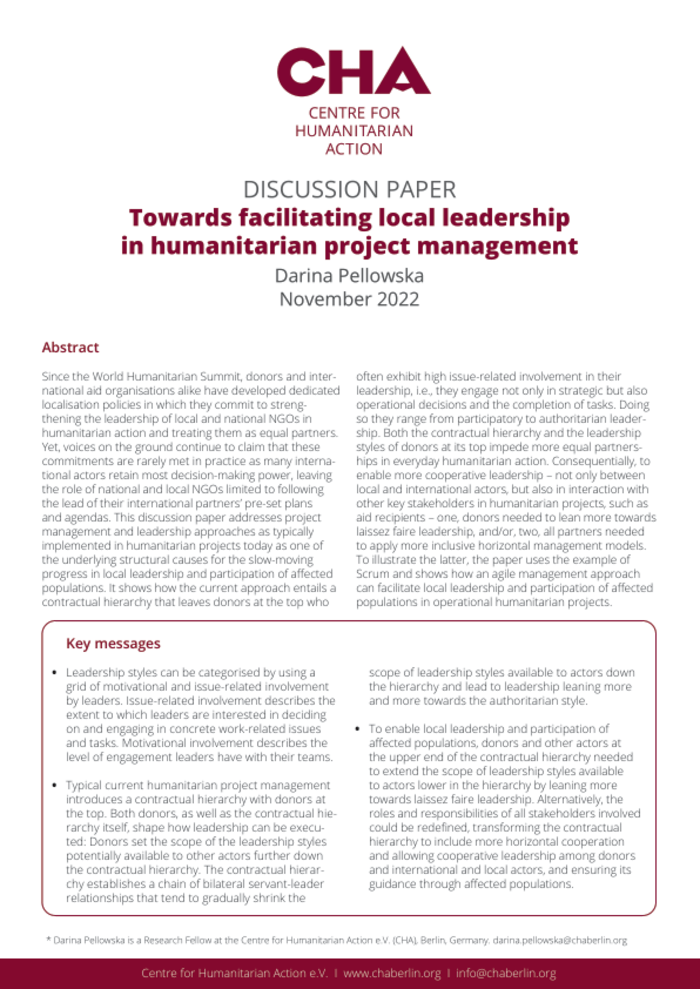
Key messages
• Leadership styles can be categorised by using a grid of motivational and issue-related involvement by leaders. Issue-related involvement describes the extent to which leaders are interested in deciding on and engaging in concrete work-related issues and tasks. Motivational involvement describes the level of engagement leaders have with their teams.
• Typical current humanitarian project management introduces a contractual hierarchy with donors at the top. Both donors, as well as the contractual hierarchy itself, shape how leadership can be executed: Donors set the scope of the leadership styles potentially available to other actors further down the contractual hierarchy. The contractual hierarchy establishes a chain of bilateral servant-leader relationships that tend to gradually shrink the scope of leadership styles available to actors down the hierarchy and lead to leadership leaning more and more towards the authoritarian style.
• To enable local leadership and participation of affected populations, donors and other actors at the upper end of the contractual hierarchy needed to extend the scope of leadership styles available to actors lower in the hierarchy by leaning more towards laissez faire leadership. Alternatively, the roles and responsibilities of all stakeholders involved could be redefined, transforming the contractual hierarchy to include more horizontal cooperation and allowing cooperative leadership among donors and international and local actors, and ensuring its guidance through affected populations.
1. Introduction
The concept of leadership has been subject to humanitarian studies and debate for a good ten years now. While largely limited to the contexts of humanitarian coordination and leadership within individual organisations (organisational development), it has resulted in a range of valuable insights. The work of Knox Clarke (2013) on “operational humanitarian leadership,” for example, identified three distinguished humanitarian leadership approaches: the exceptional individual, the structured leadership approach, and the shared leadership approach. Inspired by this and based on previous CHA research, this paper engages in an analysis of leadership approaches (or leadership styles, as they shall be called in this paper) in humanitarian project management and links this to the localisation agenda.
Doing so, the paper first introduces the managerial grid model of Blake and Mouton (1994) to define what it subsumes under the term leadership styles (Chapter 2). It then goes on to apply the grid to the context of contemporary humanitarian project management (Chapter 3). In opposition to the more homogenous leadership contexts of humanitarian coordination and organisational development that have been covered more extensively by previous research, leadership in humanitarian project management needs to address a more diverse set of actors, such as donors, intermediaries, local organisations and/or local branches of INGOs, and aid recipients who all need to effectively interact and work together to develop, design, implement and evaluate humanitarian operations, despite being all separate entities with own interests. As shall become clear in this chapter, the traditional humanitarian project management approach, as it applies in many contexts today, allows donors the power to set the leadership tone in this cooperation and define the scope of leadership styles potentially available to their partners down the project management line.
Their tendency to employ high issue-related involvement to manage their work with their direct partners (mostly international organisations), ranging from authoritarian to participative leadership, shrinks the leadership options available to the latter in managing their working relations with their subordinate partners. Chapter 4 shows that this largely contradicts the localisation agenda. It asks which leadership styles would better match the agenda and how these could be embedded in operational humanitarian project management. Chapter 5 summarises the findings and concludes that, if they take their commitments to local leadership and the participation of affected populations seriously, especially international actors, including donors, must reduce the issue-related involvement in their leadership styles in one way or another and engage in more horizontal project management.